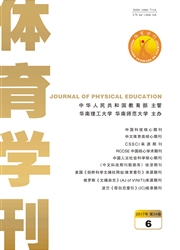

 中文摘要:
中文摘要:
以备战十二运的广东划船运动员作为研究对象,利用变异系数(CV)、黄金分割常数对常规训练监控指标进行稳定性分析和定量差异分级,通过分析监控指标与竞技成绩之间的相关性,确定训练监控的核心参数。结果发现:(1)奖牌组的运动员机能指标的稳定性普遍高于非奖牌组运动员,奖牌组运动员血清肌酸激酶(CK)和睾酮(T)的CV值显著小于非奖牌组运动员;(2)对监控指标进行定量分级,血尿素(BUN)、T和CK均可进行分级,CK最高可分4级,其中男女运动员CK及女运动员CK(1级)的定量差异在奖牌和非奖牌运动员间均呈显著性差异(1≥0.80);(3)定量分级前后CK均显示出与竞技成绩有较高相关性,其中2级CK及1级T的CV值与竞技成绩之间具有显著相关性,可作为训练监控的核心参数。CV稳定性分析和定量分级相结合可以了解指标的稳定性规律,把指标、训练强度及竞技成绩有效关联,确定“常规训练”和“过度训练”的界限,有助于制定个体化训练方案,有效鉴别优秀运动员。
 英文摘要:
英文摘要:
By basing their research object on Cantonese rowers preparing for the 12th National Games, the authors carried out stability analysis and quantitative difference classification on routine training monitoring indexes by utilizing coefficient of variation and golden division constant, determined core parameters for training monitoring by analyzing the correlations between monitoring indexes and competitive performance, and revealed the following findings: 1) the stability of functional indexes of the rowers in the medal group was generally higher than that of the rowers in the non-medal group, the CV values of serum creatine kinase (CK) and testosterone (T) of the rowers in the medal group were significantly lower than those of the rowers in the non-medal group; 2) quantitative classification carried out on monitoring indexes: blood urea (BUN), T and CK can all be classi-fied, CK can be divided into 4 levels highest, there was a significant difference (l≧0.80) in the quantitative differences of CK of the male and female rowers and CK (level 1) of female rowers between the medaled rowers and the non-medaled rowers; 3) be-fore and after quantitative classification, CK showed a high correlation with competitive performance, the CV values of level 2 CK and level 1 T were significantly correlative with competitive performance, can be used as core parameters for training monitoring. The combination of CV stability analysis and quantitative classification can let us understand index stability patterns; effectively correlating indexes, training intensity and competitive performance, and determining the boundary between “routine training” and “over training”, are conducive to making individualized training plans and effectively identifying excellent athletes.
 同期刊论文项目
同期刊论文项目
 同项目期刊论文
同项目期刊论文
 期刊信息
期刊信息
